 | WARNING: Due to the outbreak of the infectious disease COVID-19 (see coronavirus pandemic), caused by the virus SARS-CoV-2, also known as coronavirus, there are travel restrictions worldwide. It is therefore of great importance to follow the advice of the official bodies of Belgium and Netherlands to be consulted frequently. These travel restrictions may include travel restrictions, closure of hotels and restaurants, quarantine measures, being allowed to be on the street for no reason and more, and can be implemented with immediate effect. Of course, in your own interest and that of others, you must immediately and strictly follow government instructions. |
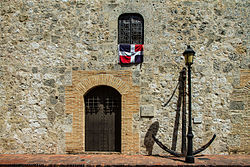 | |
| Location | |
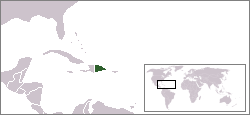 | |
| Flag | |
 | |
| Short | |
| Capital | Santo Domingo |
| Government | Representative Democracy |
| Coin | Dominican Peso (DOP) |
| Surface | total: 48,730 km2 country: 48,380 km2 water: 350 km2 |
| Population | 9,378,819 (Census Dec 2010) |
| Language | Spanish |
| Religion | Roman Catholic 95% |
| Electricity | 110/60Hz (US plug) |
| Call code | /1-809 |
| Internet TLD | .do |
| Time zone | UTC-4 |
The Dominican Republic forms together with Haiti the island of Hispaniola, which is Cuba after the largest of the Caribbean Islands.
Info
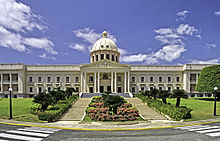
Thanks to the climate and the wonderful water sports options, this country is one of the most popular holiday destinations in the Caribbean. In addition to sun, sea and sand, the Dominican Republic also has beautiful nature — rainforests, deserts, mountain areas, waterfalls, etc. — and large cities, including the capital Santo Domingo. About 10 million people live in the Dominican Republic. The Dominican Republic is a country in the Caribbean between the islands of Cuba and Puerto Rico. The capital of the Dominican Republic is Santo Domingo, located in the south of the island. Santo Domingo is an old city, today with more than 3 million inhabitants. The old town has attractions such as the oldest university in the Western Hemisphere, the Faro a Colón and the Alcazar Colón, the palace of the son of Columbus. To the north is the well-known city of Puerto Plata, a well-known tourist destination. Just outside this city is the Playa Dorada park where many luxury hotels can be found. Villages a little further east, where many tourists also come, are Sosúa and Cabarete. In the east of the Dominican Republic, Punta Cana is the main attraction. This is truly purpose-built holiday resorts. The city is nearby Higuey, otherwise there are only a few small villages in this region. To the south, east of Santo Domingo, are the seaside towns of Boca Chica and Juan Dolio.
The mineral larimar, a green-blue variety of the mineral pectolite, is mined in the Dominican Republic.
The Dominican Republic should not be confused with the Caribbean island of Dominica.
History
The Dominican Republic forms the eastern part of the island of Hispaniola and has a rich colonial history. In 1492 the island of Hispaniola was discovered by Christopher Columbus and afterwards the island was exploited by the Spaniards. In 1697, Spain had to cede the western part of Hispaniola to France, who named it Saint-Domingue. Later, the French even took control of the entire island. Afterwards, the Spaniards, the Dominicans and then the French alternately gain power over (parts of) the island of Hispaniola.
In the eighteenth century there are several slave revolts on the island, the most important in 1791; the Haitian Revolution. This was the first in American history to succeed. These have the origin of neighboring country Haiti as a result. The Dominican Republic is declared an independent country in 1844. However, it was unsettled in the country well into the twentieth century. The country has twice been under the American flag and in the periods 1930-1961 and 1966-1978 the country is a dictatorship. Then it became democratically and politically stable.
climate
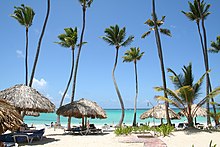
The Dominican Republic is located near the equator, so the climate is tropical. However, there is a difference in the tropical climates in the country. Most of the island has a tropical savanna climate; long dry periods with very little rainfall. The northeastern part of the Dominican Republic, however, is dominated by tropical rainforests and there is a lot of rain. In the interior in the southwestern part of the Dominican Republic there is again a steppe climate, in which it is again warm with little rain. In general, you should assume a tropical maritime climate with small temperature differences during the seasons. There is a seasonal variation in rainfall. The island is located in the middle of the hurricane zone and is subject to severe storms from June to October. It occasionally experiences floods and periodic droughts. The climate of the Dominican Republic is suitable for growing bananas and coffee.
Population

The original inhabitants of the Dominican Republic are the Taíno Indians. These Native Americans were already living in Puerto Rico and the island of Hispaniola when Columbus arrived in Hispaniola in 1492. He brought with him Spaniards, who settled in the country. Later the African slaves also arrived to work on the land. In the course of history, marriages between Spaniards, Africans and the Taínos occurred. Today, about 73 percent of Dominicans have mixed blood of African, European, and Native American ancestry.
Culture
The population of the Dominican Republic is a mixture of Spanish, Amerindian and African descent.
Holidays
The Dominican Republic's national holiday is 'Independence Day', which is celebrated on February 27. The other holidays are:
| January 1st | New Year's Day |
| 21st of January | Nuestra Senora de la Altagracia |
| January 26 | Remembrance of the birthday of Juan Pablo Duarte (January 26, 1813) |
| August 4 | Foundation Day Santo Domingo (the capital) |
| Nov 5 | Day of the Constitution |
Furthermore, the usual Christian holidays are also celebrated in the Dominican Republic, such as Easter, Ascension, Pentecost and Christmas. However, there is no Easter, Whitsun or Christmas Day.
Regions
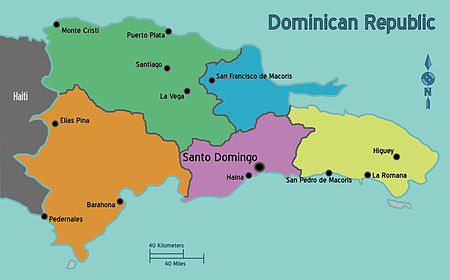
| Great Santo Domingo (Distrito Nacional, Monte Plata, peravia, San Cristobal, San Jose de Ocoa, Santo Domingo) The agglomeration of the capital and the surrounding beaches. |
| Eastern Dominican Republic (El Seibo, Hato Mayor, La Altagracia, La Romana, San Pedro de Macoris) Here are the world famous all-inclusive hotels of hotels bavaro and Punta Cana and the big resorts of Casa de Campo and Cap Cana. |
| Eastern Cibao (duarte, Maria Trinidad SanchezI, Hermanas Mirabal, samaná) A beautiful bay, often considered a "paradise on earth" |
| Western Cibao (Dayabon, Espaillat, La Vega, Monsenor Nouel, Monte Cristia, Puerto Plata, Sanchez RamirezSantiago, Santiago Rodriguez, valverde) The second largest city, the highest mountains in the Caribbean and the popular beaches of the Atlantic coast. |
| Southern Dominican Republic (Azua, barahona, Baoruco, Elias Pina, Independence, Pedernales, San Juan) The most remote part of the country, virtually untouched by tourism, with unique nature where beautiful animals live. |
Towns

- Santo Domingo - capital
- Higuey
- La Romana
- La Vega
- Puerto Plata — third city in the country
- San Cristobal
- San Francisco de Macoris
- San Pedro de Macoris
- Santiago de los Caballeros — second city in the country
Other destinations
| This article or section does not comply with the style manual or needs other operations. Dive in , give it your attention and improve it !Proposed changes: The instruction "Please, never more than a top 7 to 9 other attractions per country" has not been followed here |
- Bayahibe
- Bonao - A remote village.
- cabaret
- Constanta
- Dominic
- Jarabacoa
- Las Terrenas
- Las Galeras
- Miches
- Bahia de las Aguilas
- Playa Bonita - A secluded beach frequented by many tourists.
Arrive
The vast majority of visitors to the Dominican Republic arrive by plane at one of the airports.
Passport and visa
For residents of most countries, the passport must be valid for at least 3 months after arrival in the Dominican Republic. A visa does not need to be arranged in advance, these can be purchased for US$ 10 at the airport. It is therefore wise to always take dollars with you.
By plane
Most tourists go to Punta Cana or Puerto Plata and therefore arrive at the airports of the same name. If you have booked a trip with a hotel, you will generally be met by the tour operator, who will drop you off at your hotel.
Dutch and Belgian airlines do not fly directly to the airport of the capital Santo Domingo. Some German and especially Spanish airlines do have direct scheduled flights to Santo Domingo.
At all airports it is possible to rent a car from well-known rental companies.
By car
The chance that you enter by car via Haiti is very small
By bus
The chance that you will enter via Haiti by bus is very small
By boat
Several cruise ships call at the Dominican Republic, for these passengers the same rules apply as for air travelers.
Travel around
By plane
The Dominican Republic has approximately 35 airports, in addition to the well-known international airports, there are also airports that only deliver domestic flights. Although the Dominican Republic is not a large country, there are several domestic flights, both scheduled and charter, that fly to all corners of the country. It is also possible to take a helicopter tour over the island.
By train
There is only a metro in the capital Santo Domingo. There are plans to build a railway from Puerto Plata to Santiago.
By car
A car is the perfect means of transport to explore the Dominican Republic yourself. An off-road vehicle (Jeepeta) is preferred in order to brave the many bumps and potholes of the Dominican road network, but it is also possible with a passenger car. The driver is expected to be alert, because quite a few unexpected things happen along the way. Just like the road surface, the signage leaves a lot to be desired, and overtaking from the right or wrong-way drivers is not looked up to.
By public transport

There are several forms of public transport in the Dominican Republic. Compared to Dutch prices, public transport is not expensive, but for the average Dominican it is becoming increasingly unaffordable due to the high fuel prices.
- Motorbike taxis (Motoconchos) take you quickly from A to B within the city limits.
- Carros Publicos (Public Taxis) run a fixed route along the major roads between certain places. Everyone can get on and off wherever they want along this route. The car is only full when there are four people in the back seat and two in the front seat, in which case you are approximately on each other's lap.
- GuaGuas (taxi vans) actually do the same as the public taxis. However, many more people fit in here.
- Taxis usually wait for tourists at the hotels, for a fixed fee (many times higher than public taxis) they will take you to your destination.
- Buses also run there, both with and without air conditioning.
- Metros run in the capital Santo Domingo. It is the only city in the entire Caribbean to have a metro, and it runs from Mamá Tingó, on the north side of the city, to the Centro de los Héroes, which is right on the coast. A second metro line is being built.
By boat
It is possible to take a boat trip or catamaran trip on the sea through various (local) tour operators. It is also possible to cross the bay of Samana by ferry.
Language
The official language in the Dominican Republic is Spanish. A large part of the staff in hotels often speaks some English, but in shops and on the street you will find few English-speaking Dominicans. In tourist areas, the menus of restaurants are often in English.
To look at
To do
To buy
| This article or section does not comply with the style manual or needs other operations. Dive in , give it your attention and improve it !Proposed changes: conflicting information about pins and street switches, chapter should be completely rewritten |
The official currency of the Dominican Republic is the Dominican Peso which is referred to as RD$. Some companies, such as car rental, hotels and tour operators can also pay with US dollars or euros or with a credit card.
You can exchange money at the bank, but in tourist areas there are also many money changers on the street who appeal to tourists. The exchange rate on the street is sometimes better than that at the bank.
With most debit cards you can simply withdraw money at the various ATMs. Keep in mind that most machines give the money first, without the card coming back from the machine (so not like in the Netherlands). After this, you can choose to withdraw an amount again, without having to enter the pin code first. You won't be the first tourist to forget his pass in the vending machine!
Since 18 April 2012, all ING debit cards in the Dominican Republic have been blocked. I understood from a helpdesk employee that this is an agreement between all Dutch Banks. At Rabobank you must first indicate that you are going to the Dominican Republic and only then will you be unblocked for that specific area. ABN-AMRO also has a blockade.
If you want to pay by card in the Dominican Republic, you must bring a credit card. This is currently the only way to pay in the Dominican Republic. Furthermore, if you are in the Dominican Republic and unexpectedly do not have a credit card and still need money, you can call the emergency number of your bank. This person is then obliged to make money available to you via Western Union, the costs for this are for the bank. You must have enough money in your bank account. For ING you can call 058-2126000. They are available 24 hours a day 7 days a week.
You can also bring cash, which you can exchange at any bank. It is advisable not to do this at the hotel or at the airport, but a local bank. Switching with people on the street is also not recommended. At the airport or in the hotel you will generally get 4 to 6 pesos less for 1 euro. This can add up quite a bit. exchanging 100 euros saves about 10 euros.
Food
As with many Caribbean islands, Dominican cuisine is a mixture of influences, especially Native American and Spanish. Fresh ingredients are widely used, as is sofrito (a mixture of herbs and spices). Typical Dominican dishes are Sancocho (stew of different meats), Sopa Criolla Dominicana (meal soup with meat, pasta and onions) and Bandera Dominicana (a combination of meat, beans and rice).
The national drink of the Dominican Republic is rum made from the sugar cane that grows in abundance. There are also many rum cocktails, but also plenty of delicious drinks without alcohol, such as fruit shakes and fresh fruit juices. Mamajuana is the national health drink, made from bark, roots, herbs and a secret ingredient. According to the residents, it helps against rheumatism, abdominal complaints and other internal problems. A special feature is the coconut, a piece of which is chopped off on site to drink from. If desired, it is supplemented with rum.
Going out
stay overnight
To learn
To work
Safety
In the Dominican Republic, it is not wise to step outside the resort or hotel in the evening, when it is dark. During the day it is possible, but you should pay close attention to your personal belongings.
Health
respect
Contact
| This is a usable article. It contains information on how to get there, as well as the main attractions, nightlife and hotels. An adventurous person could use this article, but dive in and expand it! |
| Destinations | ||||||||
|---|---|---|---|---|---|---|---|---|
|

